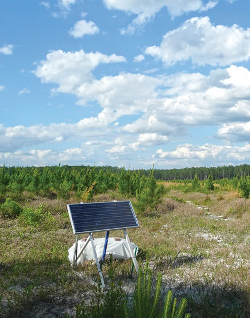
Magnetic anomaly deep within Earth's crust reveals Africa in North America

April-May GSA Today cover image.
Figuring out the origin and make-up of continental crust formed and modified by these tectonic events is a vital to understanding Earth's geology and is important for many applied fields, such as oil, gas, and gold exploration.
In many cases, the rocks involved in these collision and pull-apart episodes are still buried deep beneath the Earth's surface, so geologists must use geophysical measurements to study these features.
This new study by Elias Parker Jr. of the University of Georgia examines a prominent swath of lower-than-normal magnetism — known as the Brunswick Magnetic Anomaly — that stretches from Alabama through Georgia and off shore to the North Carolina coast.
The cause of this magnetic anomaly has been under some debate. Many geologists attribute the Brunswick Magnetic Anomaly to a belt of 200 million year old volcanic rocks that intruded around the time the Atlantic Ocean. In this case, the location of this magnetic anomaly would then mark the initial location where North America split from the rest of Pangea as that ancient supercontinent broke apart. Parker proposes a different source for this anomalous magnetic zone.
Drawing upon other studies that have demonstrated deeply buried metamorphic rocks can also have a coherent magnetic signal, Parker has analyzed the detailed characteristics of the magnetic anomalies from data collected across zones in Georgia and concludes that the Brunswick Magnetic Anomaly has a similar, deeply buried source. The anomalous magnetic signal is consistent with an older tectonic event — the Alleghanian orogeny that formed the Alleghany-Appalachian Mountains when the supercontinent of Pangea was assembled.
Parker's main conclusion is that the rocks responsible for the Brunswick Magnetic Anomaly mark a major fault-zone that formed as portions of Africa and North America were sheared together roughly 300 million years ago — and that more extensive evidence for this collision are preserved along this zone. One interesting implication is that perhaps a larger portion of what is now Africa was left behind in the American southeast when Pangea later broke up.
ARTICLE
Crustal magnetism, tectonic inheritance, and continental rifting in the southeastern United States
E.H. Parker, Jr., University of Georgia, Dept. of Geology, 210 Field St., Athens, Georgia 30602, USA, ehparker@uga.edu. GSA Today, v. 24, no. 4–5, p. 4-9; doi: 10.1130/GSAT-G192A.1.
GSA Today articles are open access online; for a print copy, please contact Kea Giles. Please discuss articles of interest with the authors before publishing stories on their work, and please make reference to GSA Today in articles published.
Contact:
Kea Giles
Managing Editor,
GSA Communications
+1-303-357-1057
kgiles@geosociety.org












